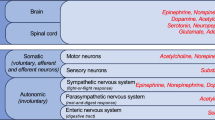Abstract
The capacity of noradrenaline (NA) and its end metabolite 3-methoxy-4-hydroxyphenylglycol (MHPG) to modulate the chemotaxis of lymphocytes from a primary immunocompetent organ (thymus) and a secondary one (spleen) was investigated over a range of concentrations from 10−12 M to 10−5 M. Lymphocyte chemotaxis was evaluated in a Boyden chamber. The results indicated that 10−5 M of NA inhibits the chemotaxis of lymphocytes from both the immunocompetent organs studied, and that this effect is blocked by either propranolol (10−6 M) or phentolamine (10−5 M). Similarly, 10−5 M of MHPG induced a decrease in the chemotaxis capacity of the lymphocytes. In conclusion, high physiological concentrations of NA and its end metabolite modulate the mobility of lymphocytes, and the participation of both alpha and beta adrenoreceptors is necessary, showing a new aspect of neuroimmune interactions.
Similar content being viewed by others
References
Besedovsky HO, del Rey A, Sorkin E, da Prada M, Keller HH: Immunoregulation mediated by the sympathetic nervous system. Cell Immunol 48: 346-355, 1979
Blalock JE: The syntax of immune-neuroimmune communication. Immunol Today 15: 504-511, 1994
Fabris N: Immune system and aging: Neuroimmunological implications. Int J Immunopath Pharmacol 5: 93-102, 1992
Friedman EM, Irwin MR: Modulation of immune cell function by the autonomic nervous system. Pharmacol Ther 74: 27-38, 1997
Felten SY, Olschowka JA: Noradrenergic sympathetic innervation of the spleen: II. Tyrosine hydroxylase (TH)-positive nerve terminals form synaptic-like contacts on lymphocytes in the splenic white pulp. J Neurosci Res 8: 37-48, 1987
Tang Y, Shankar R, Gamelli R, Jones S: Dynamic norepinephrine alterations in bone marrow: evidence of functional innervation. J Neuroimmunol 96: 182-189, 1999
Madden KS, Livnat S: Catecholamine action and immunologic reactivity. In: R. Ader, D.L. Felten, N. Cohen (eds). Psychoneuroimmunology, 2nd edn. Academic Press, San Diego, 1991, pp 283-310
Sáez MC, García JJ, De la Fuente M, Ortega E: Modulation of superoxide anion levels of macrofages from young-adult and old mice by the norepinephrine metabolite 4-hydroxy-3-metoxyphenyl-glycol. Exp Gerontol 37: 395-400, 2002
Ortega E, Galán M, De la Fuente M, Barriga C: Influence of physical activity stress and age on the ADCC of lymphocytes from mice. Arch Gerontol Geriat 16: 93-101, 1993
Boyden SV: The chemotactic effect of mixtures of antibody and antigen on polymorphonuclear leukocyte. J Exp Med 115: 453-456, 1962
Carrasco M, Del Rio M, Hernanz A, De la Fuente M: Inhibition of human neutrophil function by sulfated and nonsulfated cholecystokinin octapeptides. Peptides 18: 415-422, 1997
Del Rio M, De la Fuente M: Chemoattractant capacity of bombesin, gastrin-releasing peptide and neuromedin C is mediated through PKC activation in murine peritoneal leukocytes. Regul Pept 49: 185-193, 1994
Hugli TE: Chemotaxis. Curr Opin Immunol 2: 19-27, 1989
Roszman TL, Carlson SL: Neurotransmitters and molecular signalling in the immune response. In: R. Ader, D.L. Felten, N. Cohen (eds). Psychoneuroimmunology, 2nd edn. Academic Press, San Diego, 1991, pp 331-335
Ackerman KD, Felten SV, Bellinger DL, Livnat S, Felten DL: Noradrenergic sympathetic innervation of spleen and lymph nodes in relation to specific cellular compartments. In: B. Cinader, R.G. Miller (eds). Progress in Immunology IV. Academic Press, Florida, 1987, pp 588-600
Fernandez HN, Henson PM, Otani A, Hugli TE: Chemotactic response to human C3a and C5a anaphilotoxins. Evaluation of C3a and C5a leukotaxis in vitro and under stimulated in vivo conditions. J Immunol 120: 109-115, 1978
Ford-Hutchinson AW, Bray MA, Doig MU, Shipley ME, Smith MJH: Leukotriene B, a potent chemokinetic and aggregating substance release from polymorphonuclear leukocytes. Nature 286: 264-265, 1980
Shubert T, Müller WE: N-formyl-methionyl-leucyl-phenylalanine induced accumulation of inositol phosphates indicates the presence of oligopeptide chemoattractant receptors on circulating lymphocytes. FEBS Lett 257: 174-176, 1989
Chambers DA, Cohen RL, Perlman RL: Neuroimmune modulation: Signal transduction and catecholamines. Neurochem Int 22: 95-110, 1993
Silvestri M, Oddera S, Lantero S, Rossi GA: Beta 2-agonist-induced inhibition of neutrophil chemotaxis is not associated with modification of LFA-1 and Mac-1 expression or with impairment of polymorphonuclear leukocyte antibacterial activity. Resp Med 93: 416-423, 1999
Ortega E, Garcia JJ, Sáez MC, De la Fuente M: Changes with aging in the modulation of macrophages by norepinephrine. Mech Ageing and Dev 188: 103-114, 2000
Hadden JW, Hadden EM, Middleton E: Lymphocyte blast transformation-I. Demonstration of adrenergic receptors in human peripheral lymphocytes. Cell Immunol 1: 583-595, 1970
Rasmusson AM, Hauger RL, Morgan CA, Bremner JD, Charney DS, Soutwick SM: Low baseline and yohimbine-stimulated plasma neuropeptide Y (NPY) levels in combat-related PTSD. Biol Psychiatry 47: 526-539, 2000
Benschop RJ, Rodríguez-Feuerhahn M, Schedlowski M: Catecholamine-induced leukocytosis: Early observations, current research, and future directions. Brain Behav Immun 10: 77-91, 1996
Author information
Authors and Affiliations
Rights and permissions
About this article
Cite this article
José García, J., del Carmen Sáez, M., de la Fuente, M. et al. Noradrenaline and its end metabolite 3-methoxy-4-hydroxyphenylglycol inhibit lymphocyte chemotaxis: Role of alpha- and beta-adrenoreceptors. Mol Cell Biochem 254, 305–309 (2003). https://doi.org/10.1023/A:1027349904589
Issue Date:
DOI: https://doi.org/10.1023/A:1027349904589




